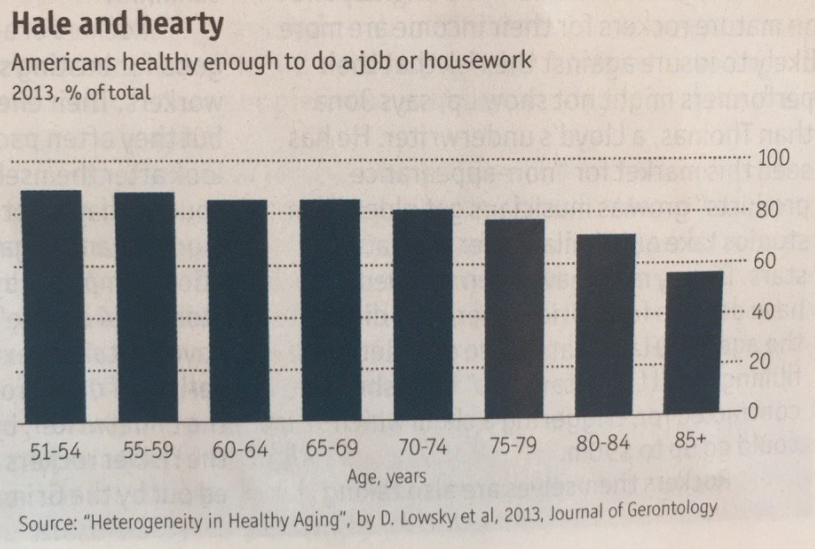Hale & Hearty: The Aging Dilemma
Should a 70-year-old American be considered “old”? Statistically, your average 70-year-old has just a 2% chance of passing away within a year. The estimated upper limit of today’s average life expectancy is 97 years old, and a rapidly growing number of 70-year-olds will live past age 100.
Perhaps more importantly, many 70-year-olds today are in much better shape than their grandparents were at the same age. So how do you define the term “old” in today’s environment of increasing longevity? In most developed countries, healthy life expectancy after age 50 is growing faster than life expectancy itself, suggesting that the “old age” period of diminished vigor and ill health is often deferred until a person has reached their early to mid-80s.

A recent series of articles in The Economist suggests that we need to devise a new term for people between the ages 65 to 80, who are generally “hale and hearty”; a group of individuals who are capable of performing knowledge-based work on an equal footing with 25-year-olds, but are increasingly being shunted out of the workforce by their younger counterparts. The article suggests that if this 65-to-80 cohort does not start participating in the workplace at a higher rate, the impact on our economy and society could be catastrophic.
Globally, a combination of falling birth rates and increasing lifespans threatens to increase the old-age dependency ratio – the ratio of retired people to active workers – from 13% in 2015 to 38% by 2100. This lopsided ratio could lead to major fiscal strains on our pension and Social Security systems, because fewer workers will be paying into the retirement benefits for an ever-increasing pool of retirees.
How can this dilemma be addressed? The articles note that whenever a new stage of life is defined and popularized, a wave of profound societal and economic changes have followed.
For instance, the conception of childhood in the mid-19th century paved the way for child labor and protection laws, compulsory schooling and the emergence of new businesses that focus on children (from toy making to children’s books). Another example: when teenagers were first identified as a distinct demographic in the 1940s, the value of the U.S. economy increased substantially as a result of their willingness to work part-time and to freely spend their income on new goods and services.
Instead of classifying people between the ages of 65-80 as “old” or “retired”, we should consider defining a new stage of life that recognizes the contributions of senior citizens and encourages capable people to continue participating in the workforce.
Fortunately, an increasingly large constituency of people ages 65-80 has transitioned into the “gig economy”, taking on part-time roles that emphasize knowledge and relationships. They are often content to work part-time, are not actively looking for career progression, and are better able to deal with the precariousness of such jobs. Businesses that seek on-demand lawyers, accountants, teachers, personal assistants and drivers are finding plenty of recruits among older people.
Still others are preparing for life beyond retirement by becoming entrepreneurs. In America, people between ages 55 and 65 are 65% more likely to start a new business than people who are 20-34 years old. In Britain, 40% of new business founders are over age 50, and 60% of employed people over age 70 are self-employed.

One of the largest economic contributions made by older people is often overlooked: volunteerism and child care support. More than 40% of Americans ages 65+ regularly volunteer their time and talent to serve their communities. In Italy and Portugal, about 20% of grandmothers provide daily care for a grandchild. That frees the parents to work longer hours and save a huge bundle on child care services.
All of these changes are indicative of a reality that is not well-publicized: that the traditional retirement age increasingly makes no sense in terms of our senior citizens’ health, longevity and ability to contribute to our society. The sooner we find an appropriate classification for healthy people between the ages of 65-80, the faster we can begin to fully appreciate their potential to contribute.

